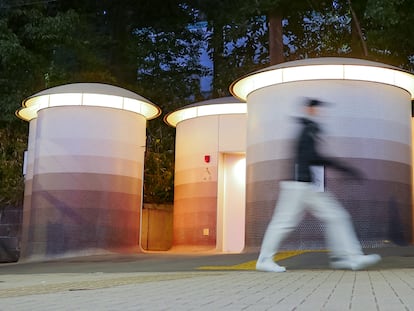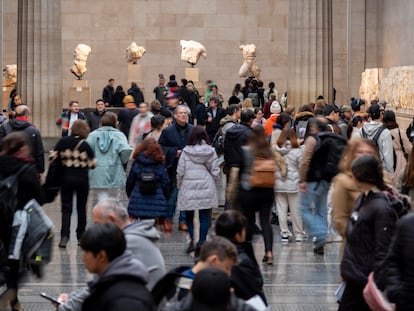Hidden gems of the Royal Palace of Madrid
A tour of the General Archives and Royal Library takes us into two areas full of ancient and valuable items that are never seen by regular visitors of the Spanish landmark building
Madrid’s Royal Palace stands atop what was once the old Alcázar, a strategic enclave built in the ninth century by the Muslims. The fortress was rebuilt in the 16th century as a royal palace by Charles I, the first monarch of the Hapsburg dynasty. But a terrible fire destroyed the building on Christmas Eve of 1734, during the reign of Philip V, the first Bourbon monarch. The Royal Palace that we know today was built on those ashes in 1735, its design based on the work of Italian architect Filippo Juvarra. His untimely death left Juvarra’s disciple, Juan Bautista Saccheti, in charge. The task fell to Saccheti to modify the palace design in accordance with the court’s tastes. After much back-and-forth, the building was commissioned. It rooms, décor and works of art are now enjoyed by visitors (they totaled 1.4 million in 2023). But there are two areas that normal guests may not enter, save on rare occasions: the General Archives and the Royal Library, both of them home to ancient books, documents, photographs, architectural plans, musical scores, parchments, engravings, drawings, maps, letters … This EL PAÍS special offers a unique opportunity to get to know some of these hidden jewels of the Royal Palace.
The general archives
The general archives of the Royal Palace are located on the side of the building that overlooks the Campo del Moro gardens. They house the royal family’s documents, stemming back to the time of Charles I in the 16th century, until 1931, when the second republic was announced and Alfonso XIII was exiled. They start up again in 1939, the year that Franco’s dictatorship began, and continue through to the late 1990s. The royal archives are composed of three floors with 53 rooms and 12.5 linear kilometers of shelves. Directed by Juan José Alonso, the archive is primarily used by researchers, roughly 4,000 of them every year, who make around 15,000 queries, in addition to 2,000 remote queries.
Created in 1814 upon the return of Ferdinand VII to Spain and the crown, the archive’s earlier versions were consolidated into the centralized space that exists today. Its peaceful rooms were disturbed in 1848, when Isabel II decided to install a theater within the palace walls. The architect entrusted with the project situated it in the area that had previously been dedicated to the archive, and the transition was bumpy, with insufficient time dedicated to the transfer of documents and even a period in which the building was left exposed to the elements. Just three years later, the theater was shuttered and the archive returned to its original location. It was largely unaffected by the Spanish Civil War, although some damage had to be addressed by renovations in 1963 and 1987.
The bulk of the Archive is made up of court documents. It features a religious section, where texts related to the Royal Chapel are housed; another one that is dedicated to the Royal Chamber and the monarchs’ private affairs; the Royal Cavalry, which pertains to protocols for leaving the palace, and the Royal Household, whose writings detail the management of goods.
There are also around 65,000 photographs located in the archive, including the first known shots taken of the Prado Museum and of the interior of the Royal Palace itself. Here too are housed 12,000 architectural plans, 11,500 account books, 2,500 scores, 1,600 posters and 1,400 parchments.
The Royal Archive’s oldest document was created in 1148. It details an orchard owned by the Segovia cathedral that was donated to the abbey of Párraces, which was located in the same Catalan province.






The archive consists of 12.5 linear kilometers of shelving. These contain, for example, around 12,000 architectural plans, which in some cases have required special storage shelves be built, due to their size. All of the plans have been digitized.








The archive also houses objects and documents that reflect life in the palace and how it was administered.








The archive also preserves letters that different kinds of people sent to the palace. They present a way of studying the people, problems and social relations of each era.






The Royal Palace’s archives began to be digitalized in 1996. Today, there are more than 850,000 digitalized images of its documents. Its photographic section preserves around 65,000 pieces, including four daguerreotypes. More than 80% of the archive, and nearly all of its architectural plans, have been digitized.








The Royal Library
The Royal Library is located on the ground floor of the Royal Palace, in a corner overlooking the Campo del Moro gardens on one side and the Caballerías esplanade on the other. It is made up of 10 rooms, and is directed by Nuria Torres. Initially, it was referred to as the royal private or the library of the bedchamber, the latter due to fact that it was located close to the king and queen’s bedchamber. At the time, it was the royal family’s private library, which had been created by Henry V with 6,000 of his own volumes. The first ruler of the Bourbon dynasty translated books from French, his native language, and was also a writer. In 1711, he also founded the Royal Public Library, the predecessor of the National Library of Spain, which became property of the government in 1836.


Nowadays, the Royal Library is composed of around 280,000 volumes, including 4,660 manuscripts (from between the 12th and 20th centuries) and 263 incunabulum. The majority of the volumes are from the 18th century and, in addition to their titles, they are distinguished by their varied and rich bindings, and they form one of the best collections in Europe, particularly the books that were made between the 15th and 18th centuries. Around 3,000 of these jewels of the Royal Library’s collection have been digitized, and some 200 works are kept in a vault due to their high value, such as a first edition of Don Quixote from 1605. In addition, there are 17,000 engravings and drawings, 1,119 photograph albums and 7,000 maps.
The books are characterized by their ex libris, markings that proclaim who they belonged to, which are formed by inscriptions or stamps, such as the so-called royal cipher, typically consisting of the ruler’s initial and a number. The Royal Library’s collections are mainly used by researchers and, in addition to Spanish, there are works in a variety of European languages as well as Arabic, Chinese, Hebrew and Persian.
The treasures of the Royal Library stand out due to their binding, which reflects the tastes of different monarchs, as well as general trends. Although Philip created the collection, other rulers with bibliophilic passion have included Charles III and Charles IV, who bought numerous collections; and even the nefarious Ferdinand VII.












The Royal Library also has a rich collection of sheet music that was assembled by Barbara of Portugal, a cultured woman who was wife to Ferdinand VI. Another monarch, Charles IV, bought several collections from private individuals, of which perhaps the most significant was that of the Count of Gondomar, who was Philip III’s ambassador to England. The count’s library was composed of books, manuscripts and a correspondence of some 20,000 letters. Upon the death of Ferdinand VII in September of 1833, the monarchs’ private library was moved to the space it now occupies by order of his widow, María Cristina of Bourbon.
These beautifully bound books have been preserved in very good conditions, in part because their use is quite limited and they are only available to researchers, who can consult them in the salon of musical allegories, so named due to the room’s decoration. There are books about lineages, weapons, nobility, bylaws … In order not to damage the earliest specimens, they are not affixed with a symbol to indicate their placement, but rather are hung a sign that is called a tejuelo (shingle).










The scientific cataloguing of the Royal Library’s holdings began during the reign of Alfonso XII. Since then, its main mission has been to conserve its heritage and to build upon it, selectively. This bibliographic catalog has been available online since 2002.
Among the space’s many curiosities, one stands in a corner of the room: a piece of trompe l’oeil furniture. What appear to be the spines of books are actually decoration of a cabinet that contains missals, or liturgical texts. The case is located in the part of the library that enjoys the most shade, all the better to preserve its numerous volumes. The Royal Apothecary also preserves some 1,100 liturgical books.
Finally, there are manuscripts in Indigenous American languages that were collected by priest, botanist and geographer Celestino Mutis on his many expeditions. These were part of an imperial project headed by Catherine the Great of Russia, who planned to collect dictionaries of all the languages of the world. She asked Charles III for grammar and vocabulary books of the American languages. The viceroys were able to commission the volumes, but when they arrived at the Spanish court, Charles III thought better of his own largesse and declined to send them on to Russia, instead incorporating them in the royal chamber library in 1787.
The Royal Library does not only house books, but also other kinds of documents and objects related to important historical figures and events.












Credits:
Sign up for our weekly newsletter to get more English-language news coverage from EL PAÍS USA Edition






